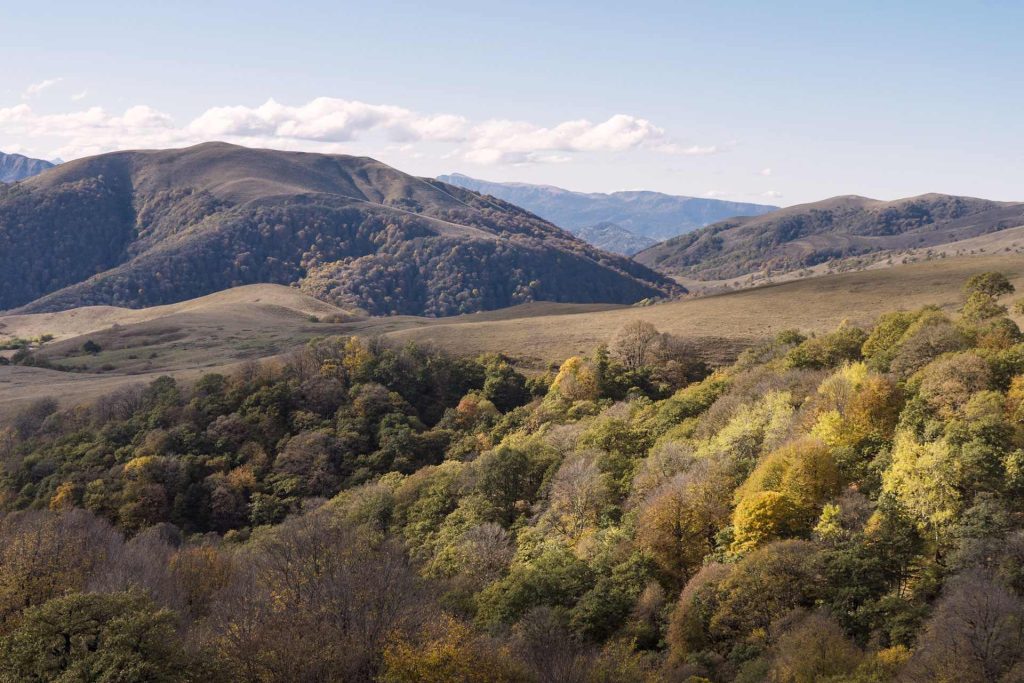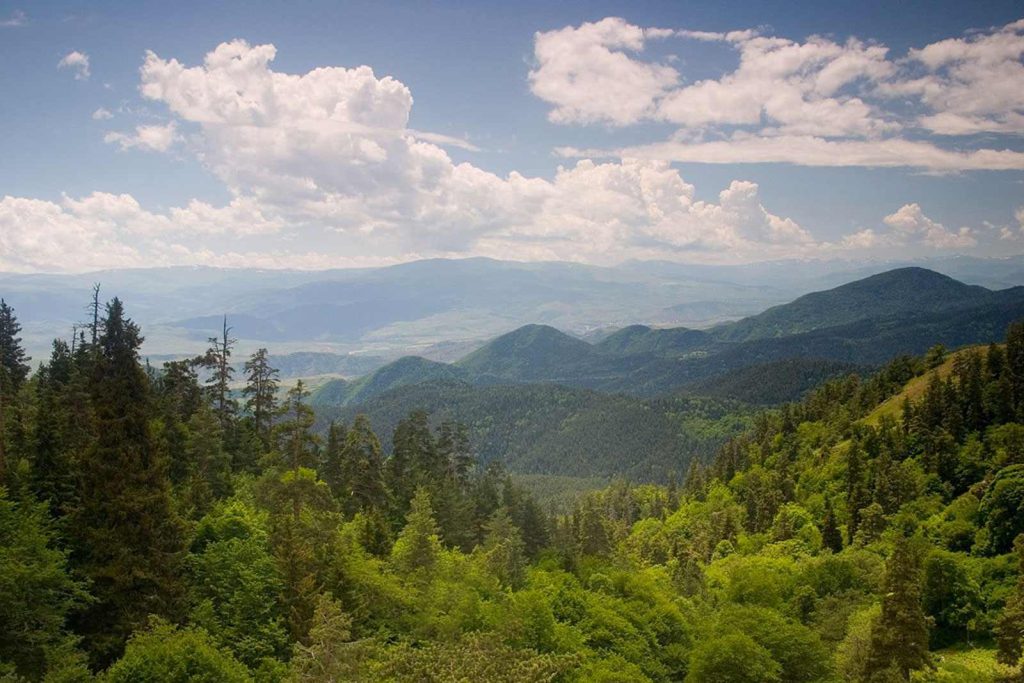Located in the Kvemo Kartli mountains, Algeti National Park (in Georgian: ალგეთის ეროვნული პარკი, algetis erovnuli parki) offers a haven for nature lovers and those looking to disconnect from urban life. With its vast mountainous landscapes, well-marked hiking trails, and rich biodiversity, this park has become a favorite destination for hikers, campers, and bird watchers. Throughout your visit, you’ll have the chance to explore ancient canyons, discover local flora and fauna, and immerse yourself in the region’s history and culture. Find everything you need to know in this detailed guide to enjoy an unforgettable visit to this Georgian national park.
Content
- 1 Information about Algeti National Park
- 2 How to Get to Algeti National Park
- 3 Geography of Algeti
- 4 Flora of Algeti (Kvemo Kartli)
- 5 Fauna of Algeti
- 6 Recommended Excursions and Activities
- 7 What to See and Do in Algeti National Park
- 7.1 Algeti River Valley
- 7.2 Kldekari Canyon
- 7.3 Tsalka (Dashbash) Canyon
- 7.4 Samshvilde Canyon
- 7.5 Birtvisi Fortress
- 7.6 Kldekari Fortress
- 7.7 Didgori Valley
- 7.8 Arsena Cave
- 7.9 Church of the Assumption of the Virgin Mary in Manglisi
- 7.10 Kldekari Mountain
- 7.11 Algeti Trail
- 7.12 Kedi Trail
- 7.13 Picnic Areas
- 7.14 Nature Observation Areas
- 8 Cultural Heritage of Algeti National Park
- 9 Gastronomy around Algeti
- 10 Accommodations in and around Algeti National Park
Information about Algeti National Park
History
Algeti National Park was established in 1965 as a protected area to preserve its rich biodiversity. Over time, the park has become an important tourist site, attracting people interested in its unique combination of nature, culture, and history. Initially, the area was primarily used as a forest reserve, but today it is valued for both its natural surroundings and historical heritage.
Algeti covers 6,044 hectares, with the Algeti reserve occupying 23% of the total area.
Location
The park is located in the Kvemo Kartli region, southeast of Tbilisi, Georgia’s capital, just an hour away. The park covers a mountainous area, with altitudes ranging from 1,100 to 1,950 meters above sea level, offering spectacular views of the surrounding valleys and mountains.
Best Time to Visit Algeti National Park
For those looking to enjoy the park at its best, the ideal time to visit is during spring and autumn, when the temperatures are mild and the flora is in full bloom. During these seasons, the trails come alive, offering an ideal experience for hiking and nature observation.
How to Get to Algeti National Park
From Tbilisi
The park is just 60 kilometers from Tbilisi and can be reached by car or public transportation in approximately an hour and a half. Minibus routes regularly depart from the Didube bus station. The visitor center is located in Manglisi, Kurorti Street 4.
From Rustavi
Rustavi, another nearby city, is located 80 kilometers from the park. The drive takes about two hours, and there are also available minibus connections.
From Bolnisi
Bolnisi is situated 90 kilometers from the park, and the drive takes about two and a half hours. While public transportation options are more limited, local minibuses can take you closer to the park.
From Marneuli
Marneuli is another nearby option, located 70 kilometers away. The drive takes around an hour and a half, making it a convenient route for those in the Kvemo Kartli region.
From Telavi
From the city located in the eastern part of Georgia, in the Kakheti region, it’s about 120 km to the park’s entrance. The drive takes approximately 2 hours and 38 minutes.
Geography of Algeti
The park extends across a mountainous region with rugged terrain and deep valleys. The mountain peaks offer panoramic views, while the Algeti River flows through the park, creating canyons and areas of geological interest. The park’s geographic diversity ranges from rocky mountains to dense forests, making it a perfect destination to explore different natural landscapes.
Flora of Algeti (Kvemo Kartli)
The park is home to a rich diversity of plant species. Among the most common trees are oak, pine, and fir, which form dense forests in the higher areas. During spring, the meadows are filled with wildflowers, creating a colorful spectacle that attracts nature and photography enthusiasts.
You’ll find a coniferous forest with oriental spruce, yew (Taxux baccata), fir, and Caucasian pine, with the latter two species growing at an altitude of 1,100 to 1,850 meters above sea level. There’s also the presence of Caucasian rhododendron (Rhododedron caucasicum).
The flora of Algeti National Park consists of 1,664 plant species, including:
- 80 tree species.
- 800 herb species.
- 156 plant species:
- 43 poisonous.
- 24 edible plants.
- 69 ornamental species.
- 3 Georgian Caucasian species.
- 514 fungus species:
- 183 micromycetes.
- 331 macromycetes.
- 187 lichen species.
- 304 aquatic plants.
- 150 types of mosses.
Among the plant species are Colchic, Iberian, Iranian-Caucasian, and Asian flora, Hyrcanian flora, wild cherry, viburnum, and mesophilic flora from the eastern Mediterranean. The Hyrcanian flora includes Hyrcanian maple, Rhamnus palassi, and Astragalus, with three other endemic species in the area.
Rare and Endangered Species
The park’s vegetation and plant species are abundant, with special attention given to the endangered species that grow in Algeti National Park:
- High-mountain oaks.
- Georgian walnuts.
- Sea buckthorn (Hippophaerhamnoides).
- Caucasian astragalus.
- Yew.
- Elm.
Fauna of Algeti
The park’s fauna includes a wide variety of species, from mammals to birds. Among the most notable animals are deer, wild boar, and several species of foxes. Additionally, the park is an ideal spot for observing birds of prey like eagles and falcons, often seen soaring above the mountain peaks.
Recommended Excursions and Activities
Algeti National Park offers several hiking trails that vary in difficulty, from easy walks to more challenging routes for adventurers. The trails are well-marked and provide a unique opportunity to explore the park’s diverse ecosystems. Camping is also available, an ideal activity for nature lovers. Camping in the park is a great option as there are designated areas for overnight stays, where you can enjoy the tranquility of the natural surroundings and spend a night under the stars.
Another recommended activity in Algeti is birdwatching. The park’s protected area is a paradise for birdwatchers. With a wide variety of resident and migratory species, you can spot everything from small songbirds to birds of prey.
Additionally, cycling routes in the park allow visitors to cover great distances while enjoying the mountainous landscapes. The gentle slopes in certain areas make this an accessible activity for both beginners and experienced cyclists.
What to See and Do in Algeti National Park
Algeti River Valley
The Algeti River runs through the park, creating a beautiful valley surrounded by lush forests. It is an ideal spot for hiking or simply enjoying a picnic by the water.
Kldekari Canyon
The Kldekari Canyon is one of the park’s key attractions, with its steep walls and breathtaking views of the surrounding landscape. It can be accessed via hiking trails that offer spectacular vistas. It is part of the park’s Dashbashi Canyons.
Tsalka (Dashbash) Canyon
This canyon is known for its stunning waterfalls and dramatic cliffs. The trails surrounding the Tsalka Canyon allow you to enjoy panoramic views and explore the natural caves hidden in the rocks. It is one of the most popular destinations for those seeking adventure in the mountainous landscapes.
Samshvilde Canyon
The Samshvilde Canyon is a site of great historical and natural importance. Along its cliffs, you can find the remains of the medieval citadel of Samshvilde, offering a unique combination of archaeology and stunning scenery. It is an ideal location for history and geology enthusiasts.
Birtvisi Fortress
This ancient fortress, located atop a rocky peak, is one of the park’s most enigmatic sites. You can view the ruins of Birtvisi while enjoying the expansive views over the valley. The routes to the fortress are quite challenging, adding a sense of adventure to the experience.
Kldekari Fortress
Built in the 9th century, Kldekari Fortress overlooks the landscape from its strategic location in the mountains. The ruins of the fortress serve as a reminder of the region’s military and strategic importance throughout the centuries. Today, it is an excellent place to explore while enjoying views over the surrounding valleys.
Didgori Valley
Didgori Valley is famous for its natural beauty and historical significance. It is the site of the historic Battle of Didgori in 1121. Besides its cultural importance, the valley offers vast landscapes ideal for hiking and nature walks.
Arsena Cave
Arsena Cave is an interesting geological formation located within the park. According to legend, it was used as a refuge by the Georgian folk hero Arsena Odzelashvili. Exploring the cave allows you to delve into local history and mythology while enjoying a unique natural setting.
Church of the Assumption of the Virgin Mary in Manglisi
This church is one of the oldest religious monuments in Georgia, with a history dating back to the 6th century. Its architecture stands out for its simplicity and elegance, and the site holds great spiritual significance for locals. The church is located near the park and is a recommended stop for those interested in the region’s religious history.
Kldekari Mountain
Kldekari Mountain is a popular destination for hikers. From its summit, panoramic views of the park and beyond can be enjoyed, making it a perfect spot for those seeking a high-altitude adventure.
Algeti Trail
This trail crosses the park and connects several major points of interest, such as the river valley and Kldekari Mountain. It’s an excellent option for those who want to explore most of the park in a single hike.
Kedi Trail
A 16 km circular trail that winds through the entire park, skirting the protected area so you can hike and get an overview of everything Algeti has to offer.
Picnic Areas
The park has several designated picnic areas, allowing visitors to enjoy an outdoor meal while relaxing in the midst of nature.
Nature Observation Areas
Various points in the park have been set up for observing local wildlife and flora. These areas are perfect for those looking to photograph wildlife or simply enjoy the tranquility of the environment. There are around 14 observation barriers for protection during wildlife viewing, making them suitable for all ages.
Cultural Heritage of Algeti National Park
Ruins of Ancient Fortresses
Throughout the park, you will find the remains of ancient fortresses dating back several centuries. These structures offer a glimpse into the region’s past and are a testament to its rich history.
Nearby Historical Monuments
In addition to the ruins within the park, the areas surrounding Algeti also house various historical monuments, including monasteries and medieval fortresses that are worth visiting during your stay.
Gastronomy around Algeti
Traditional Dishes of Kvemo Kartli
The Kvemo Kartli region is known for its traditional dishes, which include meat-based recipes, fresh vegetables, and local spices. Some of the most popular dishes you can try include khinkali (stuffed dumplings) and mtsvadi (meat skewers).
Local Food from Nearby Villages
The nearby villages also offer a delicious variety of local food. Don’t miss the opportunity to try fresh produce and homemade dishes that reflect the region’s culinary traditions.
Accommodations in and around Algeti National Park
Accommodations in Tsalka
Tsalka, a nearby town, offers several accommodation options, from small guesthouses to larger hotels, making it a good base to explore the area.
Hotel in Manglisi
Manglisi offers accommodation options closer to the park, with the possibility of finding cabins and rural houses that allow you to be in direct contact with nature.
Camping Options in the Park
For those who prefer a closer experience with nature, the park offers several designated camping areas. These sites are equipped with basic facilities to ensure a comfortable and safe stay.
Next recommended parks: National Parks of Georgia.












